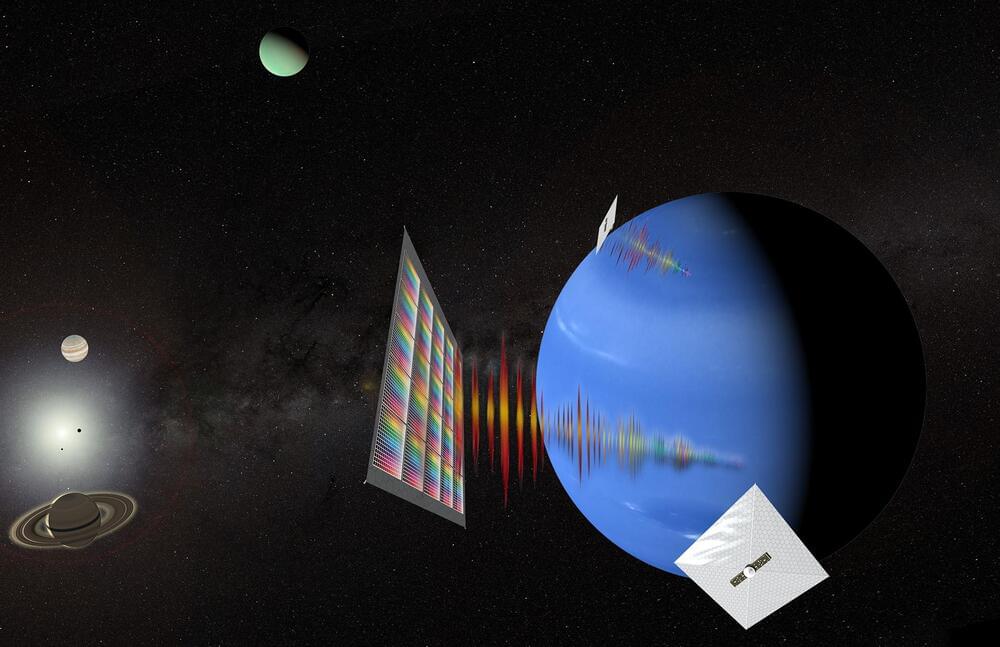A nano-scale sensor technology records precise signatures of light striking a surface.


All around smart guy Dr Goerge Church talking about genetic engineering technologies.
George Church, Ph.D. is a professor of genetics at Harvard Medical School and of health sciences and technology at both Harvard and the Massachusetts Institute of Technology. Dr. Church played an instrumental role in the Human Genome Project and is widely recognized as one of the premier scientists in the fields of gene editing technology and synthetic biology.
EPISODE LINKS:
Show notes and transcript: https://www.foundmyfitness.com/episodes/george-church.
Dr. George Church on Twitter: https://twitter.com/geochurch.
Dr. George Church on Instagram: https://www.instagram.com/george.church.
Church lab: https://arep.med.harvard.edu/
Regenesis Book: https://www.amazon.com/Regenesis-Synthetic-Biology-Reinvent-…atfound-20
PODCAST INFO:
Email: https://www.foundmyfitness.com/newsletter.
Apple Podcasts: https://podcasts.apple.com/us/podcast/foundmyfitness/id818198322
Spotify: https://open.spotify.com/show/5QjpaU0o1Q2MkVZwwG3y7d.
RSS: https://podcast.foundmyfitness.com/rss.xml.
CHAPTERS:


The technology is based on integrated circuits, which typically rely on silicon semiconductors in order to process information in a way that is similar to the role played by the brain in the human body.
The research team discovered that integrated circuits capable of performing computational tasks could be achieved using “nearly any material” around us.
“We have created the first example of an engineering material that can simultaneously sense, think and act upon mechanical stress, without requiring additional circuits to process such signals,” said Ryan Harne, an associate professor of mechanical engineering at Penn State.

Our approach to aligning AGI is empirical and iterative. We are improving our AI systems’ ability to learn from human feedback and to assist humans at evaluating AI. Our goal is to build a sufficiently aligned AI system that can help us solve all other alignment problems.
Our alignment research aims to make artificial general intelligence (AGI) aligned with human values and follow human intent. We take an iterative, empirical approach: by attempting to align highly capable AI systems, we can learn what works and what doesn’t, thus refining our ability to make AI systems safer and more aligned. Using scientific experiments, we study how alignment techniques scale and where they will break.
We tackle alignment problems both in our most capable AI systems as well as alignment problems that we expect to encounter on our path to AGI. Our main goal is to push current alignment ideas as far as possible, and to understand and document precisely how they can succeed or why they will fail. We believe that even without fundamentally new alignment ideas, we can likely build sufficiently aligned AI systems to substantially advance alignment research itself.


Earth’s interior is a far from quiet place. Deep below our surface activities, the planet rumbles with activity, from plate tectonics to convection currents that circulate through the hot magmatic fluids far underneath the crust.
Now scientists studying satellite data of Earth have identified something inside Earth we’ve never seen before: a new type of magnetic wave that sweeps around the surface of our planet’s core, every seven years.
This discovery could offer insight into how Earth’s magnetic field is generated, and provide clues of our planet’s thermal history and evolution – that is, the gradual cooling of the planetary interior.
Modulating Autophagy To Promote Healthspan — Dr. Ana Maria Cuervo, M.D., Ph.D., Albert Einstein College of Medicine.
Dr. Ana Maria Cuervo, M.D., Ph.D. (https://www.einsteinmed.edu/faculty/8784/ana-maria-cuervo/) is Co-Director of the Einstein Institute for Aging Research, and a member of the Einstein Liver Research Center and Cancer Center. She serves as a Professor in the Department of Developmental & Molecular Biology, and the Department of Medicine (Hepatology), and has the Robert and Renée Belfer Chair for the Study of Neurodegenerative Diseases.
Dr. Cuervo studied medicine and pursued a Ph.D. in biochemistry and molecular biology at the University of Valencia, as well as post-doctoral work at Tufts, and in 2001 she started her laboratory at Einstein, where she studies the role of protein-degradation in aging and age-related disorders, with emphasis in neurodegeneration and metabolic disorders.
Dr. Cuervo’s group is interested in understanding how altered proteins can be eliminated from cells and their components recycled. Her group has linked alterations in lysosomal protein degradation (autophagy) with different neurodegenerative diseases including Parkinson’s, Alzheimer’s and Huntington’s disease. They have also proven that restoration of normal lysosomal function prevents accumulation of damaged proteins with age, demonstrating this way that removal of these toxic products is possible. Her lab has also pioneered studies demonstrating a tight link between autophagy and cellular metabolism. They described how autophagy coordinates glucose and lipid metabolism and how failure of different autophagic pathways with age contribute to important metabolic disorders such as diabetes or obesity.
Dr. Cuervo is considered a leader in the field of protein degradation in relation to biology of aging and has been invited to present her work in numerous national and international institutions, including name lectures as the Robert R. Konh Memorial Lecture, the NIH Director’s, the Roy Walford, the Feodor Lynen, the Margaret Pittman, the IUBMB Award, the David H. Murdock, the Gerry Aurbach, the SEBBM L’Oreal-UNESCO for Women in Science, the C. Ronald Kahn Distinguished Lecture and the Harvey Society Lecture. She has organized and chaired international conferences on protein degradation and on aging, belongs to the editorial board of scientific journals in this topic, and is currently co-editor-in-chief of Aging Cell.

Aging is a complex and inevitable process that affects all organisms – and it is associated with tissue dysfunction, susceptibility to various diseases, and death [1]. The development of strategies like cellular reprogramming for increasing the duration of healthy life and promoting healthy aging is difficult since the mechanism of aging is not understood clearly. Aging is known to be associated with several hallmarks of aging – such as epigenetic alterations, genomic instability, cellular senescence, telomere shortening, mitochondrial dysfunction and altered intercellular communication.
Aging can be divided into two major phases: healthy aging and pathological aging. Healthy aging is the phase where the accumulation of minor alterations takes place, but pathological aging is the phase where clinical diseases and disabilities predominate along with the impairment of physiological functions [2].
Longevity. Technology: Notions regarding cells undergoing a unidirectional differentiation process during development existed previously [3]. However, in recent years cellular reprogramming using transcription factors has emerged as an important strategy for the rejuvenation of aging cells, erasing markers of cell damage and restoring epigenetic markers. These transcription factors also known as Yamanaka factors include Oct4, Sox2, Klf4, and c-Myc (OSKM). They can convert terminally differentiated somatic cells into pluripotent stem cells which are capable of dividing into any cell type of the body and thus can improve the health and longevity of individuals.